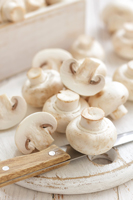Really stop to think about your diet. How many servings of fruits and vegetables did you honestly have yesterday? In response to that question, many people sigh and think, I need more veggies. It’s just too inconvenient to eat healthfully! Research agrees with that inner voice telling you to eat more veggies. In fact, for […]
Tag: Cancer
Cancer risks during each decade of life – Women
Women are diagnosed with more new cases of cancer each year than men. However, men have more cancer mortality. For both genders a lot of these cases are preventable. The American Cancer Society estimates that out of the 555,000 Americans who will die of cancer this year, approximately 170,000 will die because of tobacco use, and 19,000 will die of causes related to excessive alcohol consumption. In addition, approximately one-third of the cancer deaths are related to poor nutrition, obesity, inactivity, and other lifestyle factors and could be prevented. A healthy lifestyle lowers your lifetime risk of cancer dramatically. Research suggests that only about 20 percent of all cancers are caused primarily by genetic factors.
The most common-occurring cancers among women (other than skin cancer) are those of the breast, lung, and then colon. The order changes when you consider cancer deaths. In females, lung cancer is the leading cause of cancer death, followed by breast and then colon cancer. Although most people fear cancer, few people realize that an individual’s risk of certain types of cancer changes with each decade of life.
20s
Most women during their 20s are thinking primarily about their career and finding a life mate. Cancer is usually not a primary concern. However, cervical cancer is a foremost risk during this decade. Most women are familiar with the Pap test, the most widely used screening test for cervical cancer. It can detect precancerous changes in cervical cells; these can be treated before aggressive cancer develops. The American Cancer Society recommends annual Pap smears to screen for cervical cancer when women become sexually active or at age 18 (whichever comes first).
Read more about Cancer risks during each decade of life – Women …
Fight Cancer With Fiber
New research confirms what nutritionists have said for years–eating lots of high-fiber foods is a great way to protect your health. That might sound like an outrageous claim. But according to researchers conducting the biggest-ever study into the relationship between diet and cancer, it’s the truth. For 15 years the European Prospective Investigation of Cancer and Nutrition (EPIC) has examined the dietary habits of more than 400,000 people in nine European countries. EPIC researchers released preliminary results from their long-term cohort study at a nutrition conference last year in Lyons, France.
Cancer risks during each decade of life – Men
The American Cancer Society estimates that approximately 1.3 million new cancer cases will be diagnosed in the United States this year (excluding skin cancers). More than 1,500 people die every day because of cancer. It is our second-leading cause of death, surpassed only by heart disease.
Read more about Cancer risks during each decade of life – Men …
Cancer… Again
How lucky can a person be, anyway? Five years’ worth of lucky? That’s the target date most oncologists quote for official membership as a breast cancer survivor. Really, the buildup begins at three years running. You start to feel a tingle of hope. Four years? Now, that’s different. You might as well forget the tingle and confess downright anticipation. It’s the ultimate home stretch.
Human Papillomavirus and Cervical Cancer
Cervical cancer is the second most common form of cancer among women and one of the leading causes of early death in women worldwide. Here in the United States, 14,500 cervical cancer cases are diagnosed each year and 4,800 women die as a result of the disease. Cervical cancer deaths can be prevented with early detection and later initiation of sexual activity: the earlier the diagnosis and treatment, the higher the survival rate.
Arsenal of Prevention
When I think of cancer, my mind takes a stroll down memory lane. I see scores of women and children-women diagnosed with breast, ovarian, or uterine cancer; children fighting leukemia, bone cancers, or muscle sarcomas.
During a routine examination I found an enlarged kidney containing a renal cell cancer in one middle-aged woman. Another patient’s pelvic adenopathy alerted me to the diagnosis of malignant lymphoma.
Read more about Arsenal of Prevention …
Thinking About Drinking Milk?
As scientific investigators have traced the causes of heart disease, cancer, arthritis, migraines, and digestive problems, the least likely suspect had to be milk. We poured it on our cereal, pushed it on our children, and couldn’t imagine it to be anything but healthful. But more and more researchers now view milk with skepticism about its benefits and concern about its risks. They are linking the epidemics of prostrate cancer, digestive problems, and other ills to our habitual consumption of specific foods including-and especially-milk.
Garlic
 Garlic (Allium sativum), a member of the lily family, is possibly the most popular herb in world cuisines. While it originated in central Asia, garlic has been cultivated worldwide for millennia. Garlic has been used throughout the centuries for both food and medicine. Garlic owes much of its popularity in Europe to the Benedictine monks who grew garlic in their monastery gardens.
Garlic (Allium sativum), a member of the lily family, is possibly the most popular herb in world cuisines. While it originated in central Asia, garlic has been cultivated worldwide for millennia. Garlic has been used throughout the centuries for both food and medicine. Garlic owes much of its popularity in Europe to the Benedictine monks who grew garlic in their monastery gardens.
The Greek historian Herodotus reported that large amounts of garlic, radishes, and onions were consumed by construction workers of the Egyptian pyramids. He claimed that the large amounts of garlic were necessary to protect the builders from illnesses. In the ancient Codex Ebers, an Egyptian medical papyrus, no less than 22 of the medicinal formulations contained garlic.
Read more about Garlic …
Mushrooms
 There are more than 14,000 types of mushrooms. About 3,000 of those are edible, and 700 have known medicinal properties. Here’s an up close look at this surprisingly healthy food.
There are more than 14,000 types of mushrooms. About 3,000 of those are edible, and 700 have known medicinal properties. Here’s an up close look at this surprisingly healthy food.
Mushrooms are well known for their taste, texture, and versatility. During cooking the flavor normally intensifies, so they are a savory addition to anything from soups and salads to sandwiches and pizza. In fact, mushroom extracts are increasingly being added to food supplements and health beverages.
Read more about Mushrooms …





